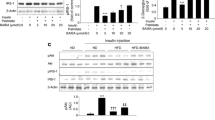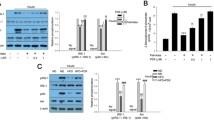Abstract
NLRP3 inflammasome is a key contributor to obesity-related insulin resistance and type 2 diabetes (T2D). Adenosine monophosphate-activated protein kinase (AMPK) is a principle intracellular energy sensor exerting protective effect against T2D. Strikingly, compound C, an inhibitor of AMPK, considerably inhibited the secretion of IL-1β when THP-1 cells were stimulated with LPS plus palmitic acid (PA). The underlying mechanism was examined with respect to the effect of compound C on NLRP3 inflammasome, a multiprotein complex which controls the processing and production of IL-1β. Interestingly, compound C significantly attenuated the activation of NLRP3 inflammasome. This phenomenon was reproduced in AMPK siRNA-transfected THP-1 cells, indicating that compound C exerts this function despite AMPK knockdown. Also, it significantly suppresses the mitochondria-generated reactive oxygen species (ROS) required for NLRP3 inflammasome activation. In conclusion, compound C was shown to significantly attenuate the NLRP3 inflammasome despite AMPK knockdown, rendering it as the novel target of compound C. Potentially, compound C attenuates NLRP3 inflammasome through the suppression of mitochondrial ROS production. These findings offer initial evidence into compound C as a novel pharmacological agent with significant therapeutic potential in NLRP3 inflammasome-related disorders, including obesity, insulin resistance, and T2D. Thus, further studies are essential to identify the effect of compound C on these diseases in vitro.





Similar content being viewed by others
References
Bullon P, Alcocer-Gomez E, Carrion AM, Marin-Aguilar F, Garrido-Maraver J, Roman-Malo L, Ruiz-Cabello J, Culic O, Ryffel B, Apetoh L, Ghiringhelli F, Battino M, Sanchez-Alcazar JA, Cordero MD (2016) AMPK phosphorylation modulates pain by activation of NLRP3 inflammasome. Antioxid Redox Signal 24:157–170. https://doi.org/10.1089/ars.2014.6120
Dinarello CA (2011) Interleukin-1 in the pathogenesis and treatment of inflammatory diseases. Blood 117:3720–3732. https://doi.org/10.1182/blood-2010-07-273417
Donath MY, Shoelson SE (2011) Type 2 diabetes as an inflammatory disease. Nat Rev Immunol 11:98–107. https://doi.org/10.1038/nri2925
Duewell P, Kono H, Rayner KJ, Sirois CM, Vladimer G, Bauernfeind FG, Abela GS, Franchi L, Nuñez G, Schnurr M, Espevik T, Lien E, Fitzgerald KA, Rock KL, Moore KJ, Wright SD, Hornung V, Latz E (2010) NLRP3 inflammasomes are required for atherogenesis and activated by cholesterol crystals. Nature 464:1357–1361. https://doi.org/10.1038/nature08938
Emerling BM, Viollet B, Tormos KV, Chandel NS (2007) Compound C inhibits hypoxic activation of HIF-1 independent of AMPK. FEBS Lett 581:5727–5731. https://doi.org/10.1016/j.febslet.2007.11.038
Gao Y, Zhou Y, Xu A, Wu D (2008) Effects of an AMP-activated protein kinase inhibitor, compound C, on adipogenic differentiation of 3T3-L1 cells. Biol Pharm Bull 31:1716–1722. https://doi.org/10.1248/bpb.31.1716
Gupta S, Maratha A, Siednienko J, Natarajan A, Gajanayake T, Hoashi S, Miggin S (2017) Analysis of inflammatory cytokine and TLR expression levels in type 2 diabetes with complications. Sci Rep 7:7633. https://doi.org/10.1038/s41598-017-07230-8
Harte AL, Varma MC, Tripathi G, Mcgee KC, Al-Daghri NM, Al-Attas OS, Sabico S, O’Hare JP, Ceriello A, Saravanan P, Kumar S, Mcternan PG (2012) High fat intake leads to acute postprandial exposure to circulating endotoxin in type 2 diabetic subjects. Diabetes Care 35:375–382. https://doi.org/10.2337/dc11-1593
He Y, Hara H, Nunez G (2016) Mechanism and regulation of NLRP3 inflammasome activation. Trends Biochem Sci 41(12):1012–1021. https://doi.org/10.1016/j.tibs.2016.09.002
Kahles F, Findeisen HM, Bruemmer D (2014) Osteopontin: a novel regulator at the cross roads of inflammation, obesity and diabetes. Mol Metab 3:384–393. https://doi.org/10.1016/j.molmet.2014.03.004
Kim YM, Kim MY, Kim HJ, Roh GS, Ko GH, Seo HG, Lee JH, Chang KC (2011) Compound C independent of AMPK inhibits ICAM-1 and VCAM-1 expression in inflammatory stimulants-activated endothelial cells in vitro and in vivo. Atherosclerosis 219:57–64. https://doi.org/10.1016/j.atherosclerosis.2011.06.043
Labuzek K, Liber S, Gabryel B, Bułdak L, Okopien B (2010) Ambivalent effects of compound C (dorsomorphin) on inflammatory response in LPS-stimulated rat primary microglial cultures. Naunyn Schmiedeberg's Arch Pharmacol 381:41–57. https://doi.org/10.1007/s00210-009-0472-2
Le MQ, Kim MS, Song YS, Noh WN, Chun SC, Yoon DY (2014) Water-extracted Ampelopsis brevipedunculata downregulates IL-1beta, CCL5, and COX-2 expression via inhibition of PKC-mediated JNK/NF-kB signaling pathways in human monocytic cells. J Pharmacol Sci 126:359–369. https://doi.org/10.1254/jphs.14168FP
Lee Y, Park BH, Bae EJ (2016) Compound C inhibits macrophage chemotaxis through an AMPK-independent mechanism. Biochem Biophys Res Commun 469:515–520. https://doi.org/10.1016/j.bbrc.2015.12.015
Masters SL, Dunne A, Subramanian SL, Hull RL, Tannahill GM, Sharp FA, Becker C, Franchi L, Yoshihara E, Chen Z, Mullooly N, Mielke LA, Harris J, Coll RC, Mills KH, Mok KH, Newsholme P, Nuñez G, Yodoi J, Kahn SE, Lavelle EC, O’Neill LA (2010) Activation of the NLRP3 inflammasome by islet amyloid polypeptide provides a mechanism for enhanced IL-1β in type 2 diabetes. Nat Immunol 11:897–904. https://doi.org/10.1038/ni.1935
Pham TH, Kim MS, Le MQ, Song YS, Bak Y, Ryu HW, Oh SR, Yoon DY (2017) Fargesin exerts anti-inflammatory effects in THP-1 monocytes by suppressing PKC-dependent AP-1 and NF-kB signaling. Phytomedicine 24:96–103. https://doi.org/10.1016/j.phymed.2016.11.014
Rheinheimer J, de Souza BM, Cardoso NS, Bauer AC, Crispim D (2017) Current role of the NLRP3 inflammasome on obesity and insulin resistance: a systematic review. Metabolism 74:1–9. https://doi.org/10.1016/j.metabol.2017.06.002
Seo K, Seo S, Ki SH, Shin SM (2016) Compound C increases sestrin2 expression via mitochondria-dependent ROS production. Biol Pharm Bull 39:799–806. https://doi.org/10.1248/bpb.b15-00938
Shen QW, Gerrard DE, Du M (2008) Compound C, an inhibitor of AMP-activated protein kinase, inhibits glycolysis in mouse longissimus dorsi postmortem. Meat Sci 78:323–330. https://doi.org/10.1016/j.meatsci.2007.06.023
Shirasuna K, Takano H, Seno K, Ohtsu A, Karasawa T, Takahashi M, Ohkuchi A, Suzuki H, Matsubara S, Iwata H, Kuwayama T (2016) Palmitic acid induces interleukin-1beta secretion via NLRP3 inflammasomes and inflammatory responses through ROS production in human placental cells. J Reprod Immunol 116:104–112. https://doi.org/10.1016/j.jri.2016.06.001
Stahlman M, Pham HT, Adiels M, Mitchell TW, Blanksby SJ, Fagerberg B, Ekroos K, Boren J (2012) Clinical dyslipidaemia is associated with changes in the lipid composition and inflammatory properties of apolipoprotein-B-containing lipoproteins from women with type 2 diabetes. Diabetologia 55:1156–1166. https://doi.org/10.1007/s00125-011-2444-6
Steinberg GR, Kemp BE (2009) AMPK in health and disease. Physiol Rev 89:1025–1078. https://doi.org/10.1152/physrev.00011.2008
Steinberg GR, Schertzer JD (2014) AMPK promotes macrophage fatty acid oxidative metabolism to mitigate inflammation: implications for diabetes and cardiovascular disease. Immunol Cell Biol 92:340–345. https://doi.org/10.1038/icb.2014.11
Sun X, Hao H, Han Q, Song X, Liu J, Dong L, Han W, Mu Y (2017) Human umbilical cord-derived mesenchymal stem cells ameliorate insulin resistance by suppressing NLRP3 inflammasome-mediated inflammation in type 2 diabetes rats. Stem Cell Res Ther 8:241. https://doi.org/10.1186/s13287-017-0668-1
Tack C, Stienstra R, Joosten LA, Netea MG (2012) Inflammation links excess fat to insulin resistance: the role of the interleukin-1 family. Immunol Rev 249:239–252. https://doi.org/10.1111/j.1600-065X.2012.01145.x
Tschopp J, Schroder K (2010) NLRP3 inflammasome activation: the convergence of multiple signalling pathways on ROS production? Nat Rev Immunol 10:210–215. https://doi.org/10.1038/nri2725
Vucicevic L, Misirkic M, Janjetovic K, Vilimanovich U, Sudar E, Isenovic E, Prica M, Harhaji-Trajkovic L, Kravic-Stevovic T, Bumbasirevic V, Trajkovic V (2011) Compound C induces protective autophagy in cancer cells through AMPK inhibition-independent blockade of Akt/mTOR pathway. Autophagy 7:40–50. https://doi.org/10.4161/auto.7.1.13883
Wang S, Zhang M, Liang B, Xu J, Xie Z, Liu C, Viollet B, Yan D, Zou MH (2010) AMPKalpha2 deletion causes aberrant expression and activation of NAD(P)H oxidase and consequent endothelial dysfunction in vivo: role of 26S proteasomes. Circ Res 106:1117–1128. https://doi.org/10.1161/CIRCRESAHA.109.212530
Wang X, Jiang X, Deng B, Xiao J, Jin J, Huang Z (2019) Lipopolysaccharide and palmitic acid synergistically induced MCP-1 production via MAPK-meditated TLR4 signaling pathway in RAW264.7 cells. Lipids Health Dis 18:71. https://doi.org/10.1186/s12944-019-1017-4
Wen H, Gris D, Lei Y, Jha S, Zhang L, Huang MT, Brickey WJ, Ting JP (2011) Fatty acid-induced NLRP3-PYCARD inflammasome activation interferes with insulin signaling. Nat Immunol 12:408–415. https://doi.org/10.1038/ni.2022
Won JH, Park S, Hong S, Son S, Yu JW (2015) Rotenone-induced impairment of mitochondrial electron transport chain confers a selective priming signal for NLRP3 inflammasome activation. J Biol Chem 290:27425–27437. https://doi.org/10.1074/jbc.M115.667063
Yang Z, Kahn BB, Shi H (2010) Macrophage alpha1 AMP-activated protein kinase (alpha1AMPK) antagonizes fatty acid-induced inflammation through SIRT1. J Biol Chem 285:19051–19059. https://doi.org/10.1074/jbc.M110.123620
Yu JW, Lee MS (2016) Mitochondria and the NLRP3 inflammasome: physiological and pathological relevance. Arch Pharm Res 39:1503–1518. https://doi.org/10.1007/s12272-016-0827-4
Zhou G, Myers R, Li Y, Chen Y, Shen X, Fenyk-Melody J, Wu M, Ventre J, Doebber T, Fujii N, Musi N, Hirshman MF, Goodyear LJ, Moller DE (2001) Role of AMP-activated protein kinase in mechanism of metformin action. J Clin Invest 108:1167–1174. https://doi.org/10.1172/JCI13505
Funding
The study was funded by the New Xiangya Talent Project of the Third Xiangya Hospital of Central South University (No. JY201718).
Author information
Authors and Affiliations
Contributions
FW and ZHM conceived and designed the research. YXL conducted the main experiments. HHH and JJY contributed the new reagents and analytical tools. LLF and HH conducted the supplementary experiments during the revision. YXL, HHH, WJY, and LHW analyzed the data. FW wrote the manuscript. All authors read and approved the manuscript.
Corresponding author
Ethics declarations
Conflict of interest
The authors declare that they have no conflict of interest.
Additional information
Publisher’s note
Springer Nature remains neutral with regard to jurisdictional claims in published maps and institutional affiliations.
Rights and permissions
About this article
Cite this article
Liu, Y., He, H., Fan, L. et al. Compound C attenuates NLRP3 inflammasome despite AMPK knockdown in LPS plus palmitate-induced THP-1 cells. Naunyn-Schmiedeberg's Arch Pharmacol 393, 67–76 (2020). https://doi.org/10.1007/s00210-019-01712-4
Received:
Accepted:
Published:
Issue Date:
DOI: https://doi.org/10.1007/s00210-019-01712-4




